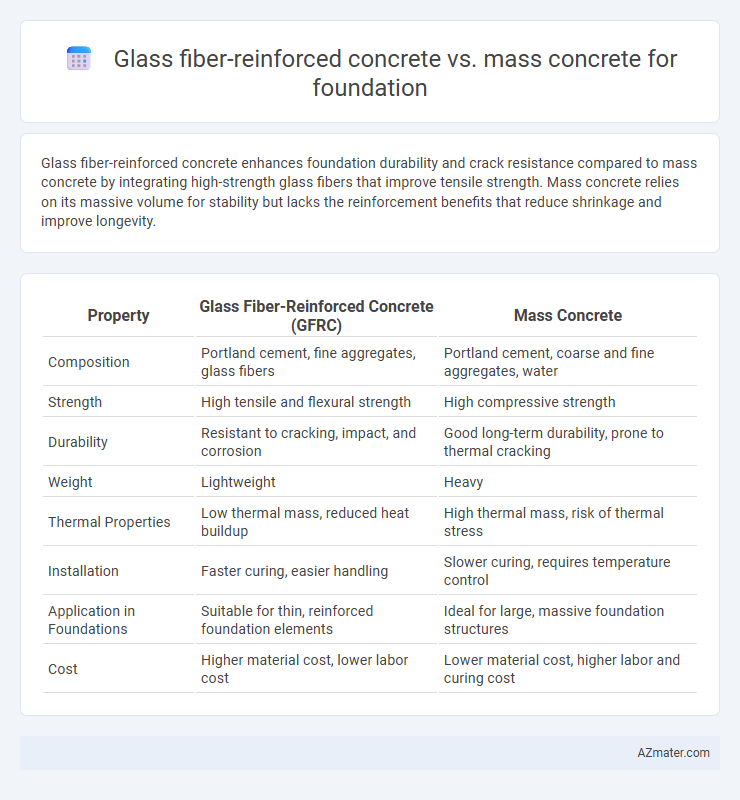Glass fiber-reinforced concrete enhances foundation durability and crack resistance compared to mass concrete by integrating high-strength glass fibers that improve tensile strength. Mass concrete relies on its massive volume for stability but lacks the reinforcement benefits that reduce shrinkage and improve longevity.
Table of Comparison
| Property | Glass Fiber-Reinforced Concrete (GFRC) | Mass Concrete |
|---|---|---|
| Composition | Portland cement, fine aggregates, glass fibers | Portland cement, coarse and fine aggregates, water |
| Strength | High tensile and flexural strength | High compressive strength |
| Durability | Resistant to cracking, impact, and corrosion | Good long-term durability, prone to thermal cracking |
| Weight | Lightweight | Heavy |
| Thermal Properties | Low thermal mass, reduced heat buildup | High thermal mass, risk of thermal stress |
| Installation | Faster curing, easier handling | Slower curing, requires temperature control |
| Application in Foundations | Suitable for thin, reinforced foundation elements | Ideal for large, massive foundation structures |
| Cost | Higher material cost, lower labor cost | Lower material cost, higher labor and curing cost |
Introduction to Concrete Foundations
Concrete foundations provide essential structural support by distributing building loads evenly to the ground. Glass fiber-reinforced concrete enhances traditional mass concrete by improving tensile strength, crack resistance, and durability without significantly increasing weight. These properties make glass fiber-reinforced concrete a superior option for foundations requiring enhanced performance under stress and environmental exposure.
Understanding Glass Fiber-Reinforced Concrete (GFRC)
Glass Fiber-Reinforced Concrete (GFRC) incorporates alkali-resistant glass fibers to enhance tensile strength, reduce cracking, and improve durability compared to traditional Mass Concrete. GFRC offers superior resistance to shrinkage and thermal stress, making it ideal for complex foundation shapes and environments prone to corrosion. The lightweight composition of GFRC also allows for faster installation and reduced structural load, providing advantages over conventional heavy Mass Concrete foundations.
Defining Mass Concrete in Construction
Mass concrete in construction refers to large volumes of concrete poured for foundations, dams, or thick structural elements where heat generated from hydration must be controlled to prevent thermal cracking. Unlike glass fiber-reinforced concrete, which incorporates fibers to enhance tensile strength and reduce shrinkage, mass concrete relies on mix design, temperature control, and placement techniques to ensure structural integrity and durability. Understanding the thermal and mechanical properties of mass concrete is essential for optimizing foundation performance in large-scale construction projects.
Key Material Properties Comparison
Glass fiber-reinforced concrete (GFRC) offers significantly higher tensile strength and improved crack resistance compared to mass concrete, which primarily relies on compressive strength. GFRC's enhanced durability and reduced permeability contribute to superior resistance against environmental degradation, making it ideal for foundations exposed to harsh conditions. Mass concrete, composed of traditional aggregates and cement, provides substantial compressive strength and thermal mass but lacks the flexibility and micro-crack control inherent in GFRC.
Structural Performance: GFRC vs Mass Concrete
Glass fiber-reinforced concrete (GFRC) offers enhanced tensile strength and crack resistance compared to mass concrete, improving overall structural durability in foundation applications. GFRC's lightweight composition reduces dead load on the foundation while maintaining high compressive strength, leading to better load distribution and reduced settlement risks. In contrast, mass concrete relies on its bulk and compressive strength but is more susceptible to shrinkage cracks and lower flexural capacity, which can compromise long-term structural performance.
Durability and Longevity Factors
Glass fiber-reinforced concrete (GFRC) exhibits enhanced durability and longevity for foundations due to its high tensile strength and resistance to cracking compared to traditional mass concrete. GFRC reduces shrinkage and shrinkage-induced fractures, thereby improving structural integrity and minimizing maintenance needs over time. Mass concrete often suffers from thermal cracking and lower tensile strength, which can compromise long-term durability under stress and environmental exposure.
Environmental Impact and Sustainability
Glass fiber-reinforced concrete (GFRC) significantly reduces environmental impact compared to mass concrete by using less cement, which lowers CO2 emissions during production. The enhanced durability and crack resistance of GFRC extend foundation lifespan, minimizing resource consumption and waste over time. Mass concrete's higher material volume and energy use contribute to greater carbon footprint and resource depletion, making GFRC a more sustainable choice for foundation construction.
Cost Analysis and Economic Considerations
Glass fiber-reinforced concrete (GFRC) typically incurs higher initial material costs compared to mass concrete due to the price of fibers and specialized mixing processes. However, GFRC reduces the overall project cost by minimizing labor through faster installation and lowering maintenance expenses because of its enhanced durability and crack resistance. Mass concrete offers a cost-effective solution for large foundational volumes but may lead to increased long-term expenses owing to shrinkage cracks and potential repairs, impacting the total economic efficiency of the foundation system.
Suitable Foundation Applications for Each Type
Glass fiber-reinforced concrete (GFRC) excels in foundation applications requiring enhanced tensile strength and crack resistance, such as thin slabs, precast panels, and lightweight foundation components. Mass concrete is ideal for large-scale foundations like retaining walls, bridge piers, and heavy footings, where high compressive strength and volume stability are critical. Selection depends on load-bearing requirements, environmental exposure, and project design constraints.
Conclusion: Choosing the Right Concrete for Your Foundation
Glass fiber-reinforced concrete (GFRC) offers enhanced tensile strength, crack resistance, and durability, making it ideal for foundations requiring lightweight and complex designs. Mass concrete provides superior compressive strength and thermal mass, suited for heavy-load-bearing and large-scale foundation projects. Selecting the right concrete depends on project-specific structural demands, environmental exposure, and budget considerations to ensure long-term foundation performance and stability.

Infographic: Glass fiber-reinforced concrete vs Mass concrete for Foundation
 azmater.com
azmater.com